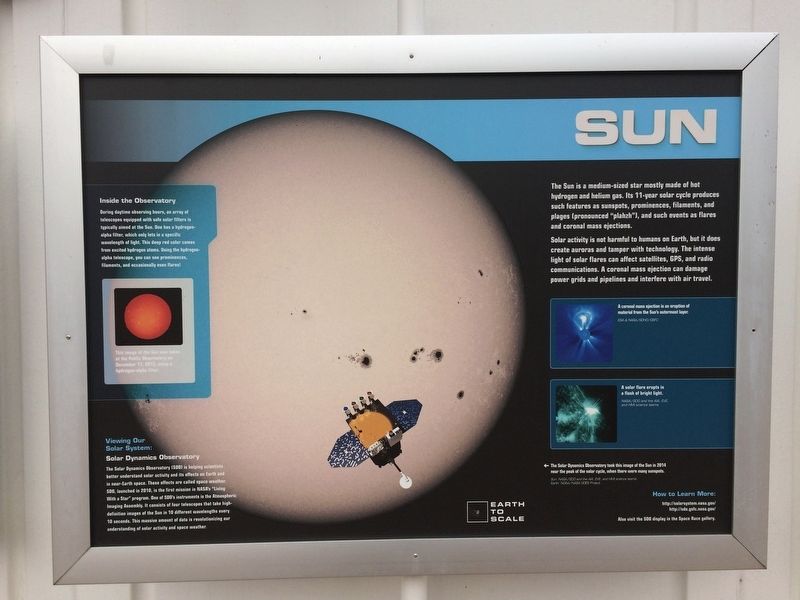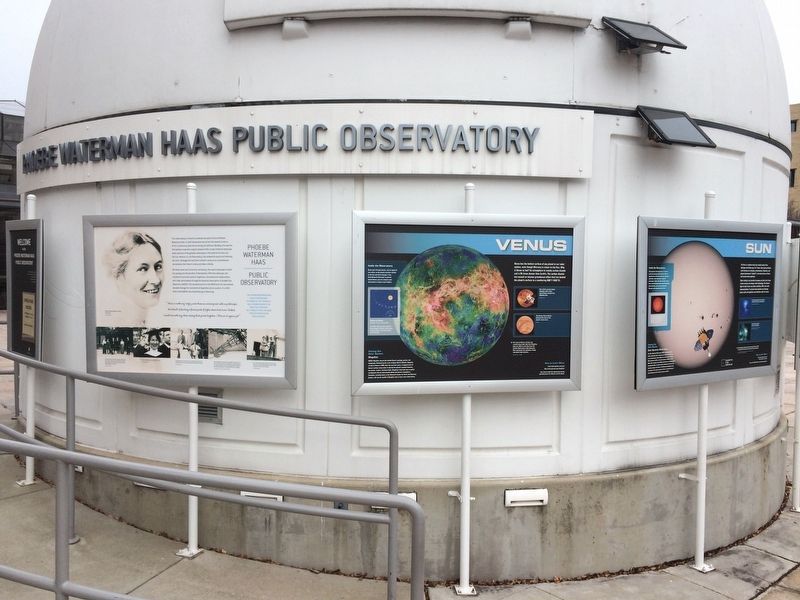The National Mall in Southwest Washington in Washington, District of Columbia — The American Northeast (Mid-Atlantic)
Sun
The Sun is a medium-sized star mostly made of hot hydrogen and helium gas. Its 11-year solar cycle produces such features as sunspots, prominence, filaments, and plages (pronounced "plahzh"), and such events as flares and coronal mass ejections.
Solar activity is not harmful to humans on Earth, but it does create auroras and tamper with technology. The intense light of solar flares can affect satellites, GPS, and radio communications. A coronal mass ejection can damage power grids and pipelines and interfere with air travel.
Captions:
Inside the Observatory
During daytime observing hours, an array of telescopes equipped with safe solar filters is typically aimed at the Sun. One has a hydrogen-alpha filter, which only lets in a specific wavelength of light. This deep red color comes from excited hydrogen atoms. Using the hydrogen-alpha telescope, you can see prominences, filaments, and occasionally even flares!
This image of the Sun was taken at the Public Observatory on December 11, 2013, using a hydrogen-alpha filter.
Viewing Our Solar System:
Solar Dynamics Observatory
The Solar Dynamics Observatory (SDO) is helping scientists better understand solar activity and its effects on Earth and in near-Earth space. These effects are called space weather. SDO, launched in 2010, is the first mission in NASA's "Living With a Star" program. One of SDO's instruments is the Atmospheric Imaging Assembly. It consists of four telescopes that take high-definition images of the Sun in 10 different wavelengths every 10 seconds. This massive amount of data is revolutionizing our understanding of solar activity and space weather.
A coronal mass ejection is an eruption of material from the Sun's outermost layer.
ESA & NASA/SOHO/GSFC
A solar flare erupts in a flash of bright light.
NASA/SDO and the AIA, EVE and HMI science teams
←The Solar Dynamics Observatory took this image of the Sun in 2014 near the peak of the solar cycle, when there were many sunspots.
Sun: NASA/SDO and the AIA, EVE, and HMI science teams
Earth: NOAA/NASA GOES Project
Earth to Scale
How to Learn More:
http://solarsystem.nasa.gov
http://sdo.gsfc.nasa.gov
Also visit the SDO display in the Space Race gallery.
Erected by Smithsonian Institution.
Topics. This historical marker is listed in this topic list: Air & Space. A significant historical year for this entry is 2010.
Location. 38° 53.273′ N, 77° 1.114′ W. Marker is in Southwest Washington in Washington
Other nearby markers. At least 8 other markers are within walking distance of this marker. Venus (here, next to this marker); Phoebe Waterman Haas (here, next to this marker); Cook Telescope (here, next to this marker); Moon (here, next to this marker); Saturn (here, next to this marker); Jupiter (here, next to this marker); Binary Stars (here, next to this marker); Star Nurseries (here, next to this marker). Touch for a list and map of all markers in Southwest Washington.
Also see . . .
1. Solar wind. (Submitted on February 14, 2018, by Jude Ramagosa of White Castle, Louisiana.)
2. NASA SDO - Aurora; What Causes Them?. Video (Submitted on February 14, 2018, by Jude Ramagosa of White Castle, Louisiana.)
Credits. This page was last revised on January 30, 2023. It was originally submitted on December 12, 2017, by Devry Becker Jones of Washington, District of Columbia. This page has been viewed 206 times since then and 9 times this year. Last updated on February 15, 2018, by Devry Becker Jones of Washington, District of Columbia. Photos: 1, 2. submitted on December 12, 2017, by Devry Becker Jones of Washington, District of Columbia. • Bill Pfingsten was the editor who published this page.

